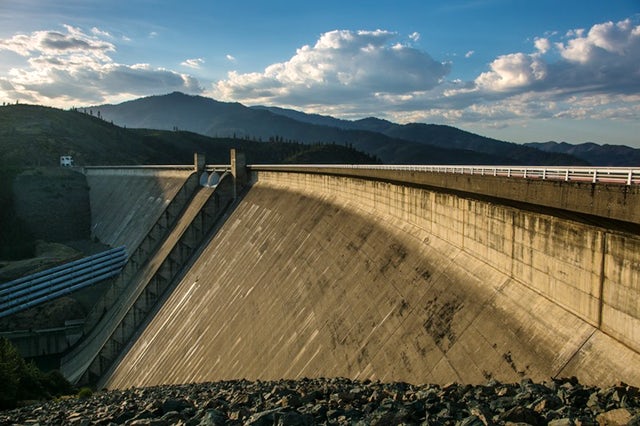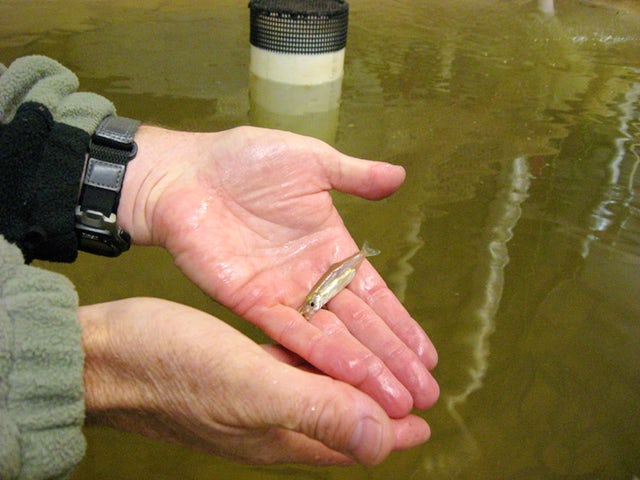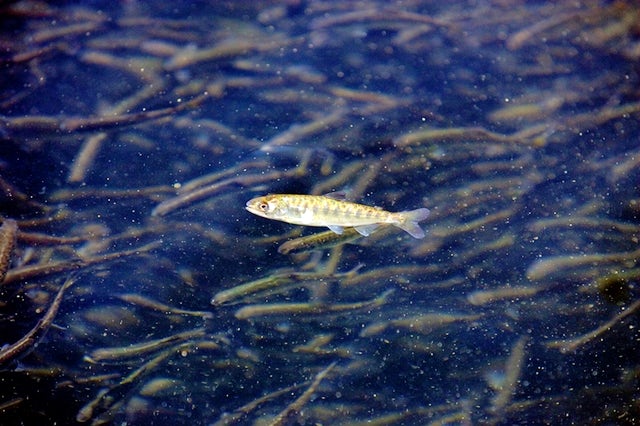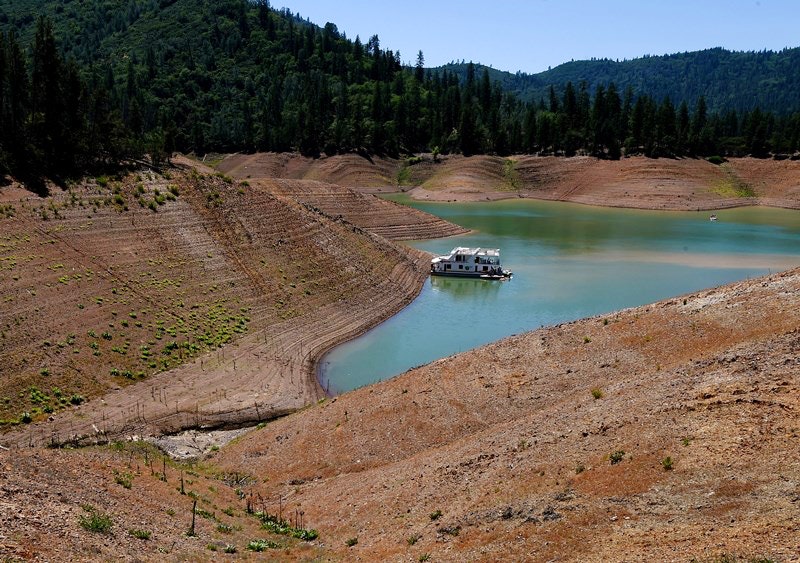From Sportfishing
Fish Report for 6-4-2018

Feds Push to Raise Shasta Dam
6-4-2018
Alastair Bland
Officials with the federal government seem determined to realize a controversial proposal to raise Shasta Dam and increase the storage capacity of the reservoir behind it – despite objections from fish and wildlife agencies and California law that technically forbids such a project. In January, the United States Bureau of Reclamation, which manages the dam, received a $20 million appropriation from Congress to begin design and preconstruction work – and, with the support of water agencies in the San Joaquin Valley, the bureau has announced plans to begin construction as early as the end of 2019.
The project, discussed informally for decades, calls for adding 18.5ft of steel and cement to the rim of the dam. This would add 634,000 acre-feet of extra storage space to Lake Shasta, already California’s largest reservoir. Agricultural interests tend to be in favor the project, while environmentalists, tribes and groups dedicated to protecting fish – especially salmon – generally oppose the idea. Several agencies that manage fish, wildlife and water in California have advised against heightening the dam, and opponents are concerned that the proposal could help mobilize a trend of federal agencies and Washington lawmakers overriding or just ignoring state environmental laws.
Making Shasta Dam higher as planned would cause a large area of Lake Shasta’s shoreline to flood in wet years, including nearly a mile of the McCloud River. This Lake Shasta tributary – once a prolific Chinook salmon stream that flowed into the Sacramento River – is strictly protected under the California Wild and Scenic Rivers Act.
In a March 2018 letter, John Laird, the secretary for the California Natural Resources Agency, asked members of Congress to “not pursue the Shasta Dam enlargement project,” primarily because heightening the dam would violate the McCloud’s Wild and Scenic protections.
But the feds don’t seem to be listening.
“Congress hasn’t yet given permission [to the Bureau of Reclamation] to waive the state law, but they did give them 20 million bucks,” said Ron Stork, senior policy advocate with the Sacramento-based group Friends of the River. Stork said the current presidential administration and the Republican-dominated Congress, recognizing the potential for Democrats to take back control of Washington, may take action to break ground on the project while they can, regardless of California law.
“Republicans may be concerned that this could be their last year for some time with a majority, so they need to strike now,” he said.
A state law that protects a river doesn’t mean it won’t be sacrificed for a large water project. When conflicts arise that pit federal laws against state laws, the federal laws usually win, said Doug Obegi, a water law attorney with the Natural Resources Defense Council. With water projects, though, it isn’t always that simple. The Reclamation Act of 1902, Obegi noted, basically requires the Bureau of Reclamation to abide by state laws when building infrastructure projects. The Water Infrastructure Improvements for the Nation Act of 2016 also requires that water projects abide by state laws. It is this very law, though, that has been used to allocate the cash for the design and preconstruction of the project, illustrating inconsistencies in how and when Congress obeys laws – even federal ones.
For lawmakers in Washington to override an iconic state law like California’s Wild and Scenic Rivers Act “would amount to breaking a line most congressmen have been reluctant to cross, but this is a fairly bold administration and a fairly bold Congress,” Stork said.
Officials have estimated that adding 18.5 vertical feet to Shasta Dam will cost $1.3 billion. Westlands Water District, a large agricultural region in the western San Joaquin Valley highly dependent on water allocated by the Bureau of Reclamation, seems to be counting on the dam being heightened. More than a decade ago, Westlands spent $35 million purchasing about 3,000 acres of land in the McCloud basin that would be flooded by the project.
This, the district’s managers explained at the time, was intended to ease or eliminate the potential for local objection to the project. The land includes area held sacred by the Winnemem Wintu Tribe, which has argued against raising Shasta Dam. A former attorney for Westlands Water District, David Bernhardt, is now the U.S. deputy secretary of the interior – a connection that Obegi, Stork and others have suggested could unfairly steer the outcome of the Shasta Dam project.
Cannon Michael, chairman of the San Luis & Delta-Mendota Water Authority, which serves 29 member agencies that receive water via the Bureau of Reclamation’s Central Valley Project, said the extra water storage that would result from the dam boost could help alleviate current strains on the water supply of California, where native fish populations teeter on the brink of extinction and farmers remain perennially unsatisfied with their own water allocations.
“Six-hundred and fifty thousand acre-feet of extra water is not something that should be dismissed out of hand,” Michael said. “We would still need to discuss the best way to use the extra water, but I think it’s likely the benefits can potentially outweigh the tradeoffs.”
But state and federal fishery officials determined the opposite in their analyses of the project. Increasing the height of Shasta Dam “would result in significant and unavoidable impacts to fish … while providing limited contributions to additional water supply,” wrote Neil Manji, the regional manager of the California Department of Fish and Wildlife in a 2013 letter addressed to the Bureau of Reclamation. The U.S Fish and Wildlife Service came to a similar conclusion, described in a 349-page report published in 2014. The agency said it had concluded “the proposed action, by further restricting high water flows, will result in additional losses of salmonid rearing and riparian habitat.”
Still, the Bureau of Reclamation has assumed the project will be, overall, good for salmon. In a 2015 feasibility report, the agency assigned taxpayers to cover just shy of 50 percent of the cost of the dam raise because the project will ostensibly benefit fish.
Erin Curtis, a spokesperson with the agency, noted that, in the 1980s, officials briefly discussed an idea to raise the dam by 200 feet.
“There was a lot of opposition to a dam raise of that magnitude,” she said. “The project being pursued today is a much-scaled-back version.”
She called the current plan “more strategic” and said it “will improve water supply reliability for agricultural, municipal and industrial, hydropower generation, and environmental uses; reduce flood damage; and improve cold-water temperatures and water quality in the Sacramento River below the dam for anadromous fish survival.”
Michael said that the last drought lucidly illustrated the need for having more storage space – or at least more water – in Lake Shasta. He noted that the Bureau of Reclamation kept more water than necessary impounded behind the dam and “basically treated the reservoir as a cold-water storage pool for fish.” If this was the agency’s strategy, it didn’t work. Nearly all the salmon eggs laid and fertilized downstream of Shasta Dam in the summers of 2014 and 2015 died in released lake water that was too warm.
“Having a bigger reservoir doesn’t make the way we use water more sustainable,” said Jon Rosenfield, a biologist and California water policy expert with the Bay Institute. “The pattern of California water use has been to use more water than we have.”
“Just raising the dam doesn’t make more water,” he added. “It could create more water in the reservoir, but only if you don’t use it.”
If the dam is raised, uncertainties will remain about how water is used and who or what will see benefits. For one thing, the project will not create more precipitation, and to fill a larger reservoir will mean holding back more water, or doing so for longer periods of time, instead of allowing that water to flow downstream. This can directly harm fish and aquatic habitat. The project will not necessarily resolve disagreements between user groups over how to handle the reservoir’s water when supplies run low during a drought.
This article originally appeared on Water Deeply. You can find the original here. For important news about water issues and the American West, you can sign up to the Water email list.
Alastair Bland is a freelance journalist in San Francisco, CA. He can be reached at allybland79@gmail.com or via Twitter.
Photos
< Previous Report Next Report >
More Reports

6-1-2018
In this episode of Deeply Talks, Tara Lohan, Water Deeply’s managing editor, speaks with University of California, Davis fisheries experts...... Read More
Chinook Salmon 'Overfished'? Not So Fast, Says Fishers
Sacramento River
3-20-2018
FOR FISHERY REGULATORS, it is official: The Sacramento River’s fall-run Chinook salmon are “overfished.” This formal designation, made in a February report from the Pacific...... Read More

Website Hosting and Design provided by TECK.net
